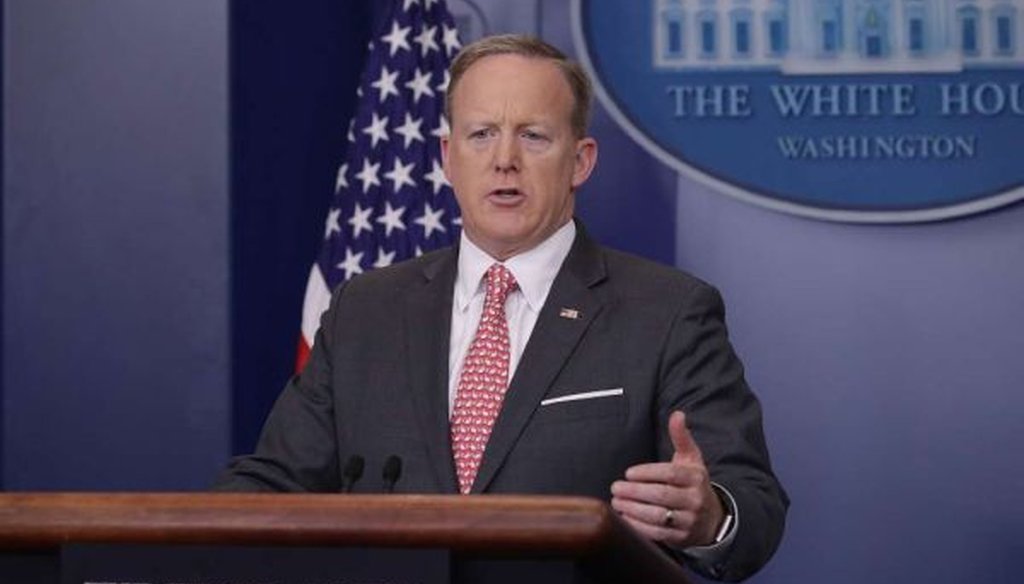Stand up for the facts!
Our only agenda is to publish the truth so you can be an informed participant in democracy.
We need your help.
I would like to contribute

White House Press Secretary Sean Spicer answers reporters' questions during the daily press briefing at the White House April 17, 2017. (Chip Somodevilla/Getty Images)
The Trump administration met widespread opposition from advocates of government transparency when it announced that it would not be publicizing the logs of White House visitors -- as the Obama White House generally had done.
Even before the change was announced, open-government groups had sued to obtain visitor records from the White House as well as Trump properties in Palm Beach, Fla., and Trump Tower in New York City.
On the Monday following the announcement, White House spokesman Sean Spicer took repeated questions about the policy at his daily briefing.
Initially, Spicer said: "I think as was noted on Friday, we're following the same policy that every administration from the beginning of time has used with respect to visitor logs."
That was wrong: Obama’s White House publicized most visitor records for more than seven years.
However, Spicer described the situation more accurately on two other occasions in the briefing, for instance when he said, "It's the same policy that every administration had up until the Obama administration."
We thought a history of the visitor-log issue was in order.
The pre-Obama policy (or lack thereof)
Historically speaking, the policy under Obama was the exception, rather than the rule -- though this is cold comfort to transparency advocates.
The Presidential Records Act allows even withheld records such as Trump’s visitor logs to be made public under the Freedom of Information Act after five years, although the president has the right to delay their release for up to 12 years.
The records act also allows the president to destroy any records the president, in consultation with the head of the National Archives, deems not to have any further administrative value.
Obama’s changes
Initially after Obama took office, the administration did not release information on White House visitors, and it refused records requests from MSNBC.com and the advocacy organization Citizens for Responsibility and Ethics in Washington.
CREW filed suit for the records in July 2009, and by September, the White House announced its intention to release some of the logs in a settlement with CREW.
Beginning on Sept. 15, 2009, the Obama White House made public the names of visitors three to four months after the visit occurred, using a special web page created for that purpose. (It is archived here.)
Obama was essentially right to say, as he did in 2010, that the administration’s move was unprecedented.
The policy, however, included a few carve-outs, including meetings that would endanger national security if publicized, sensitive meetings such as those with potential Supreme Court nominees, and purely personal visits, such as visiting friends of the Obama children.
We also gave a Compromise rating to his campaign promise to "amend executive orders to ensure that communications about regulatory policymaking between persons outside government and all White House staff are disclosed to the public."
We reasoned that while most visitor logs were being made public, logs of emails and phone calls with outside advocates were not.
Concerns remain for Trump’s transparency
Transparency advocates weren’t entirely happy with the scale of the Obama-era loopholes, including the omission of some celebrities who made personal visits to the Obama family, and Spicer emphasized this lack of completeness twice in his briefing, dismissing the Obama-era policy as a "faux attempt" at transparency.
Still, critics of Trump’s decision say they consider incomplete records -- reportedly numbering in the millions over seven-plus years -- vastly superior to no records at all.
"The Trump administration policy is a complete reversal of the policy of the Obama administration," said Craig Holman, government affairs lobbyist for the group Public Citizen.
The Obama policy was "not perfect, but it was still meaningful exposure that powered many investigative stories -- how close Google was to the White House, or how lobbyists from the pharmaceutical lobby made sure health care reform didn’t go too far," said John Wonderlich, executive director of the pro-transparency Sunlight Foundation.
"It would be disingenuous to say we won’t lose anything by going backwards."
Our Sources
White House, press briefing by Sean Spicer, April 17, 2017
PolitiFact, "White House visitor logs voluntarily released, with potential for exceptions," Jan. 27, 2010
PolitiFact, "Make White House communications public" (Obameter), Updated July 9, 2012
New York Times, "White House to Keep Its Visitor Logs Secret," April 14, 2017
Washington Post, "Trump finds himself on the defensive on a pair of government transparency issues," April 17, 2017
Email interview with Jim Harper, vice president of the Competitive Enterprise Institute, April 18, 2017
Email interview with Craig Holman, government affairs lobbyist for the group Public Citizen, April 18, 2017
Interview with John Wonderlich, executive director of the Sunlight Foundation, April 18, 2017








































